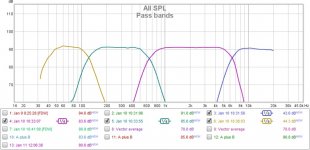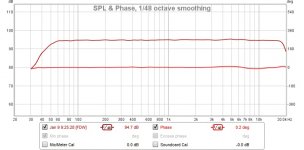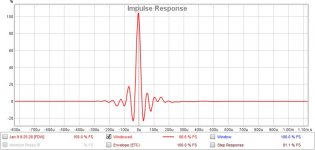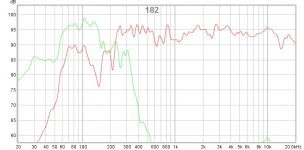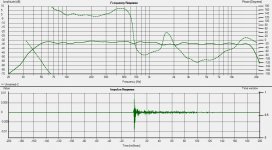Ha ha you good, if time doesn't matter well we talk about mS seconds here to reverse and repair time domain then folks with FIR DSP engines can improve on that point.
Hi BYRTT, ya beat me to it ...yes, what some mS and FIR can do for steeper sloped crossovers...
Here's a 4-way, using 48dB LR's throughout... 18", 12", and 2-way coax CD.
(I use 96 dB LR's now, but only have plots for the 3-way without sub, to show.)
ErnieM, I seem to be in the same boat as you...in needing to keep latency down for live-sound.
As much as I like using steep crossovers, the FIR time needed for phase linearization beyond 24dB/oct slopes is prohibitive. Can do 24 dB linear phase with about 12ms. (I'm also using PLD4.5s ....to drive the 3-way tops.)
Attachments
Hi BYRTT, ya beat me to it ...yes, what some mS and FIR can do for steeper sloped crossovers...
Here's a 4-way, using 48dB LR's throughout... 18", 12", and 2-way coax CD.
(I use 96 dB LR's now, but only have plots for the 3-way without sub, to show.)
ErnieM, I seem to be in the same boat as you...in needing to keep latency down for live-sound.
As much as I like using steep crossovers, the FIR time needed for phase linearization beyond 24dB/oct slopes is prohibitive. Can do 24 dB linear phase with about 12ms. (I'm also using PLD4.5s ....to drive the 3-way tops.)
Nice textbook results. Must sound loud and clear as can be with the BMS covering the important stuff.
Three-way with 1x15", 1x6", 1.4" CD through baffle no horn.
Crossovers are LR48 600hz, LR24 600&1.5khz, LR48 1.5khz
While not as pretty as the shallower slopes, it's still much better than typical steep IIR implementations. Resolution is improved over the 24/12/24 setup I was using.
I would like to see if someone can get an even better phase linearity with steep slopes.
Now with Bess48 all around.
Attachments
This is my first semi-linear phase crossover with non-coaxial sources that has nice vertical polars. A quick walk around with the mic stand revealed no major power response dips or peaks. Relatively close spacing and steep slopes helps a lot.
This is turning out to be a lower compromise project than I was aiming for. Quite happy with the audible results I'm getting. Overkill for a bass guitar amp? Yup. Though it sounds lovely with anything put through it.
Edit: For a mono system I prefer wide dispersion point sources, hence the hornless compression driver. Going for spacious sound over tight pattern control.
This is turning out to be a lower compromise project than I was aiming for. Quite happy with the audible results I'm getting. Overkill for a bass guitar amp? Yup. Though it sounds lovely with anything put through it.
Edit: For a mono system I prefer wide dispersion point sources, hence the hornless compression driver. Going for spacious sound over tight pattern control.
Last edited:
Is there a simple solid argument for the step response to be important?
Yes.
Is there a simple solid argument for the step response to be important?
Objective think a solid argument is that in natural nature there isn't any multiple excess phase filtering happening when you listen some live acoustic instruments being played, where a single wideband recording chain can come much closer to a natural step, that said in speaker domain its very hard not to introduce some compomise of distortion either here or there and in subjective psychoacostic outcome our brain and room can sometimes forgive deviations from perfect.
Is there a simple solid argument for the step response to be important?
Great question IMO...one I've struggled with alot. And not just for step response, but for impulse response as well.....
Because I keep coming back to this....
When I get ruler flat magnitude and phase...both of them ruler flat...Then step response looks awesome, as does impulse.
Heck, I think all measurements are just mag and phase shown in various ways...
And I now think step and impulse are the same thing, just shown differently.
Impulse response is so heavily weighted to the top end, I only use it to fine tune timing above maybe 6kHz. Impulse is also good at letting me see when room reflections are messing up measurements, but that's about it at my current state of learning. I don't know how to glean much from step yet, other than see how it improves with mag and phase.
So, mag and phase I know how to measure and tune.....
And 'everything' improves with their improvement.
I often wonder why I need more measurements, all they do is seem to confirm good basic measurement..I guess we need them for the room....
Because I keep coming back to this....
When I get ruler flat magnitude and phase...both of them ruler flat...Then step response looks awesome, as does impulse.
Agreed. But most speakers only have flat amplitude response. To get phase flat as well some effort is needed. Therefore most speakers sporting a linear amplitude response are lacking in the time-domain.
Regards
Charles
Agreed. But most speakers only have flat amplitude response. To get phase flat as well some effort is needed. Therefore most speakers sporting a linear amplitude response are lacking in the time-domain.
Regards
Charles
And as I remember, it is still debatable whether we can hear phase distortion - especially during playback of music.
Can we even be sure, that it is the phase correction we like to hear, or if it is the difference in aplitude response, when correcting loudspeakers with different types of DSP?
And as I remember, it is still debatable whether we can hear phase distortion - especially during playback of music.
I can... I don't doubt it. Try it for yourself, make up your own mind.
Can we even be sure, that it is the phase correction we like to hear, or if it is the difference in aplitude response, when correcting loudspeakers with different types of DSP?
Sure we can. By making a comparison with phase as the only variable. But it takes some work to get that far. Ask yourself when the phase should be right.
With programs like RePhase you can test it, be sure to answer that question first. Been there, done that.
Oh, before I forget... don't try and test it on headphones.
Last edited:
We notice more and more stuff in sound as we spend more and more time with our systems. Sometimes it is just a matter of time spent with system vs perceived sound quality (with all of its faults and goodies).
When someone does a research about perceived sound quality (as they did in Harman) he needs to train the listeners so they can be able to hear the differences they wouldn't or wouldn't appreciate the differences that much.
When they say that results about phase distortion isn't perceivable - it could be that it really isn't, or it could be that they didn't train their test listeners very well, or at all for that particular aspect of sound.
When you make phase only variable, everything else being equal, you might hear the difference immediately but you might not. It may happen that you perceive the differences after a month or two or that you need to set the phase flat and listen for a long period of time and then do the A/B comparison.
Of course it would be much easier when you have someone who knows what to listen in music to point you where are the main differences, but i gather that you can also try it on your own and draw your conclusions based on personal experience. Just, if you don't notice the differences immediately, let the music set in - it usually takes some time - at least for me.
When someone does a research about perceived sound quality (as they did in Harman) he needs to train the listeners so they can be able to hear the differences they wouldn't or wouldn't appreciate the differences that much.
When they say that results about phase distortion isn't perceivable - it could be that it really isn't, or it could be that they didn't train their test listeners very well, or at all for that particular aspect of sound.
When you make phase only variable, everything else being equal, you might hear the difference immediately but you might not. It may happen that you perceive the differences after a month or two or that you need to set the phase flat and listen for a long period of time and then do the A/B comparison.
Of course it would be much easier when you have someone who knows what to listen in music to point you where are the main differences, but i gather that you can also try it on your own and draw your conclusions based on personal experience. Just, if you don't notice the differences immediately, let the music set in - it usually takes some time - at least for me.
There is at least one paper on this subject that concludes that we do hear phase distortion, but that you first must control for in-room reflections (something that I find that most reporting back they can't hear it are typically not controlling). More on the subject here: Subconscious Auditory Effects of Quasi-Linear Phase Loudspeakers - Technical/Modifications - The Klipsch Audio CommunityAnd as I remember, it is still debatable whether we can hear phase distortion - especially during playback of music.
Can we even be sure, that it is the phase correction we like to hear, or if it is the difference in aplitude response, when correcting loudspeakers with different types of DSP?
I was quite amazed to hear the effect of phase distortions that Dave Griesinger put up on his site from his examples of moving the relative phase of higher (or lower) frequencies. See slide 17, with the punchline explained on slide 18. If you don't want to believe it then just listen to his examples. I think you'll at least be conflicted once you hear what is occurring.
I do believe that there is an issue with how different listeners have accommodated to loudspeaker/room/signal chain phase distortions (as is made clear in the Greenfield & Hawksford article first linked above). I don't believe that Harman is training listeners to hear things Harman wants them to hear, rather the opposite. They are only screening out those that have hearing damage and those that aren't using the hearing that they do have very well. In a sense, I believe that what Toole, Olive, et al. is saying there are many that have trained their hearing to the sound of direct radiating loudspeakers with all their typical distortions--not what the music and speech sounds like in person--in real life (not amplified, of course). It takes a little time to un-train listeners from that sort of thing. Greenfield and Hawksford I think also ran into that issue (reading between the lines).
Chris
And as I remember, it is still debatable whether we can hear phase distortion - especially during playback of music.
Can we even be sure, that it is the phase correction we like to hear, or if it is the difference in aplitude response, when correcting loudspeakers with different types of DSP?
+2 to Wesayso's and Cask05's comments
I think the debate over phase's audibility is heading towards an end. I think when people start hearing the benefits of truly flat phase, the tide will turn to a consensus that phase can be heard.
The debate over phase reminds me of the debate in photography at the turn of the century over how much resolution was useful in digital cameras.
A strong majority contended that the human eye couldn't see past 200 lines-per-inch (based on longstanding assessments of air-force reconnaissance photos ).
Well, it turns out 200LPI was all we could 'see' because that's all we could print !!!
Printers improved and now we can see better LoL.
I think the same phenom is going on with our 'hearing' and speakers/tuning. We are now getting to "hear phase" because of finer and finer tuning capability.
We've never really had the tools to easily achieve linear phase until fairly recently.....
Interestingly, at the driver level, where frequency response variations are largely minimum phase, you can't fix frequency response without fixing phase response. They are the same thing.
Crossovers are the big phase bugaboo...I believe as folks learn to incorporate linear phase crossovers between frequency/phase flattened drivers, more and more folks will be reporting they can hear phase.
Oh, I'd like to repeat a few caveats when trying to listen to phase...Wesayso's re headphones, and Cask05's about room reflections.
I'd like to add that global phase correction of a speaker doesn't really work (unless you are correcting full range drivers)
Global phase correction of multi-ways is too specific to tuning to one point in space IME.
Thank you for your replies.
I did not say that I do not belive that things can change. But I have still not heard a stereosystem that plays better music, just because of phase correction.
Maybe Toole has a good point, when he talks about music being created in studios via speakers that are not remotely linear - the reference point is simply not the same for the people listening to the music and the ones creating it. And maybe that is why I find most speakers with FIR filters, a bit boring and dull. I would accept that I am grown up with classic speakers, so that my perception has been in some way manipulated, and therfore needs to be unlearned.
Do you guys have some music that you could suggest, that I listen to, that reveal more or less the phase problems?
Could linear phase help with listening fatigue?
I did not say that I do not belive that things can change. But I have still not heard a stereosystem that plays better music, just because of phase correction.
Maybe Toole has a good point, when he talks about music being created in studios via speakers that are not remotely linear - the reference point is simply not the same for the people listening to the music and the ones creating it. And maybe that is why I find most speakers with FIR filters, a bit boring and dull. I would accept that I am grown up with classic speakers, so that my perception has been in some way manipulated, and therfore needs to be unlearned.
Do you guys have some music that you could suggest, that I listen to, that reveal more or less the phase problems?
Could linear phase help with listening fatigue?
I often read that exact statement: FIR filters make my speakers sound boring and dull.
That's not my experience, at all. You can read the reviews I linked in my own thread, to read opinions of others than me, I should have a colored opinion after all, as I build those things...
I asked the question: when do you want the phase to be right...
Let me give you my personal opinion on that. I want the first wave front that hits my ears to be right, as right as possible. For that to happen it needed help from the room. Every little reflection/diffraction will upset the frequency and phase as perceived at the listening spot.
In order to get to my goal I needed a way to get rid of all the first reflections. My target was to have a clean first 20 ms of sound. By looking at the IR and all graphs derived from it I started to examine my room. Trying to find all the bumps in the IR and find the corresponding cause of that bump out in the room. Those spots/walls got damping panels to absorb those reflection points. In my small room I could not work with diffusion. Only after removing those reflections could I get to my goal of clean FR/Phase. Don't try and EQ the room.
I don't have special songs I can recommend, most every song does sound better after what I have done. I did not stop at clean FR/Phase, I looked at the Studio world to find more answers. I have a virtual Haas Kicker, and even some cross talk cancellation in my current setup. That all put together does help with listeners fatigue. I'd say the sound I get is sweet but dynamic, keeps you on your toes and grabs your attention. It sucks you into the music. In fact, I could be listening right now, but know that it's difficult to stop listening and get to work in time. So I opted to write (to you) about it instead .
.
I do listen to some 'audiophile favorites' and do use a couple of songs that almost everybody knows in my demo's. One of those is the 'live' version of "Hotel California" from "Hell Freezes Over". It's always impressive.
Another favorite to impress is "Keith don't Go" from "Nils Lofgren", from the album "Nils Lofgren - Acoustic Live". Those songs easily impress and are favorites for a reason.
They do very well in my room, but so do a lot of other songs that never made it to audiophile lists. I want the best rendition of my favorite music. Not a couple of songs that should be considered to be special.
Getting this right has been a hear/feel experience... hard to describe... more 'weight' to instruments that live in mid frequencies, more realism. Goose bumps and chills down my spine are good indicators for me, head aches or a stiff neck are the signs something is off. Down the road I've had both, so I kept on working to get it right, using measurements as well as my ears. A peaky FR often is the cause of listeners fatigue, if you ask me.
P.S. Would you believe I'm almost running late again, just trying to find the right words to expres myself?
That's not my experience, at all. You can read the reviews I linked in my own thread, to read opinions of others than me, I should have a colored opinion after all, as I build those things...
I asked the question: when do you want the phase to be right...
Let me give you my personal opinion on that. I want the first wave front that hits my ears to be right, as right as possible. For that to happen it needed help from the room. Every little reflection/diffraction will upset the frequency and phase as perceived at the listening spot.
In order to get to my goal I needed a way to get rid of all the first reflections. My target was to have a clean first 20 ms of sound. By looking at the IR and all graphs derived from it I started to examine my room. Trying to find all the bumps in the IR and find the corresponding cause of that bump out in the room. Those spots/walls got damping panels to absorb those reflection points. In my small room I could not work with diffusion. Only after removing those reflections could I get to my goal of clean FR/Phase. Don't try and EQ the room.
I don't have special songs I can recommend, most every song does sound better after what I have done. I did not stop at clean FR/Phase, I looked at the Studio world to find more answers. I have a virtual Haas Kicker, and even some cross talk cancellation in my current setup. That all put together does help with listeners fatigue. I'd say the sound I get is sweet but dynamic, keeps you on your toes and grabs your attention. It sucks you into the music. In fact, I could be listening right now, but know that it's difficult to stop listening and get to work in time. So I opted to write (to you) about it instead
I do listen to some 'audiophile favorites' and do use a couple of songs that almost everybody knows in my demo's. One of those is the 'live' version of "Hotel California" from "Hell Freezes Over". It's always impressive.
Another favorite to impress is "Keith don't Go" from "Nils Lofgren", from the album "Nils Lofgren - Acoustic Live". Those songs easily impress and are favorites for a reason.
They do very well in my room, but so do a lot of other songs that never made it to audiophile lists. I want the best rendition of my favorite music. Not a couple of songs that should be considered to be special.
Getting this right has been a hear/feel experience... hard to describe... more 'weight' to instruments that live in mid frequencies, more realism. Goose bumps and chills down my spine are good indicators for me, head aches or a stiff neck are the signs something is off. Down the road I've had both, so I kept on working to get it right, using measurements as well as my ears. A peaky FR often is the cause of listeners fatigue, if you ask me.
P.S. Would you believe I'm almost running late again, just trying to find the right words to expres myself?
Last edited:
@Wesayso
Thank you for your detailed response
Personally I "only" have an IIR filter to work with right now. But I can hear that having an even FR do help alot.
Right now I cover 600 - 19Khz within +/-1,5dB
I do not compensate for the room, since I still find it difficult to believe that all the room-perfect solutions, can change the laws of acoustics.
What I do, is to measure my speakers in a reflectionfree area - well as reflection free as possible - using gating as well. Then I use 24dB LR and cross over where my midrange did not start beaming yet. So at least my reflected sound "looks" like my direct sound. My room is very uneven and I have some absorption at first reflection points and behind the speakers.
My impulse response, looks almost exactly like most other good classical speakers - no matter the price.
I will try and see if it possible to try and correct the phase with some extra software or device in the future.
I only correct for one peak in the room around 145hz. Below 90 hz I use 4 subwoofers to even out the FR - works great.
Thank you for your detailed response
Personally I "only" have an IIR filter to work with right now. But I can hear that having an even FR do help alot.
Right now I cover 600 - 19Khz within +/-1,5dB
I do not compensate for the room, since I still find it difficult to believe that all the room-perfect solutions, can change the laws of acoustics.
What I do, is to measure my speakers in a reflectionfree area - well as reflection free as possible - using gating as well. Then I use 24dB LR and cross over where my midrange did not start beaming yet. So at least my reflected sound "looks" like my direct sound. My room is very uneven and I have some absorption at first reflection points and behind the speakers.
My impulse response, looks almost exactly like most other good classical speakers - no matter the price.
I will try and see if it possible to try and correct the phase with some extra software or device in the future.
I only correct for one peak in the room around 145hz. Below 90 hz I use 4 subwoofers to even out the FR - works great.
- Home
- Loudspeakers
- Multi-Way
- S. Harsch XO
